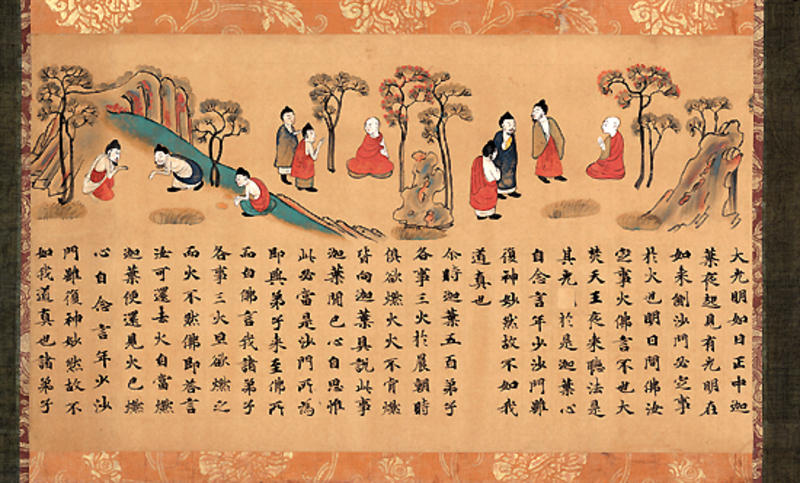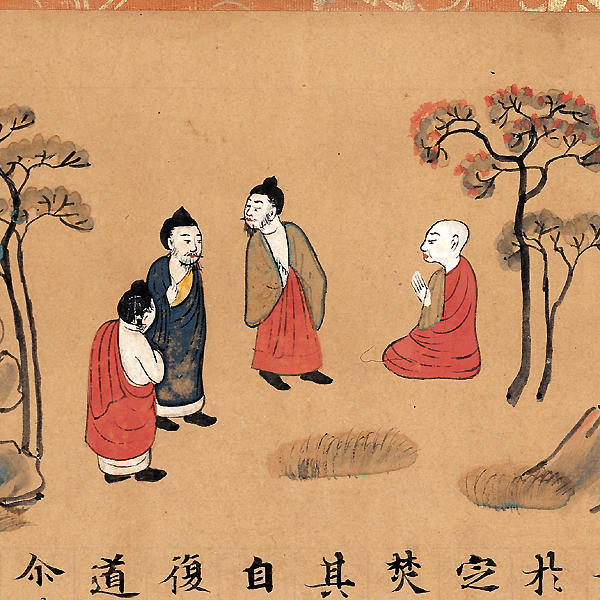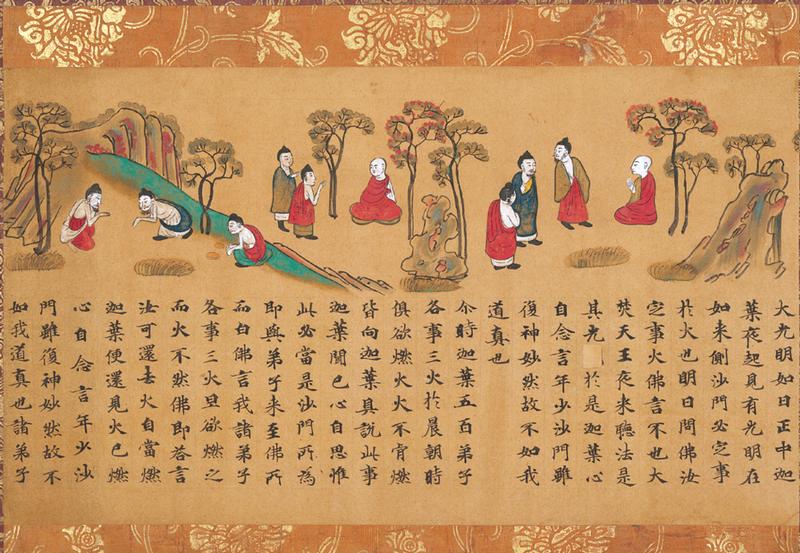絵因果経巻第四上(二十五行)
- 奈良
- 奈良時代
- 8c
- 紙本著色墨書
- H-26.5 W-46
- 所蔵
- 益田鈍翁旧蔵(益田家旧蔵本)
奈良時代 8世紀
紙本著色墨書
縦:26.5cm 横:46.0cm
「絵因果経」は,料紙を上下の二段に分け,その下段には『過去現在因果経』(劉宋,求那跋陀羅訳)の経文を一行八字詰で書写し,上段には経文の内容を絵画化したものである。
その『過去現在因果経』は仏伝の一種で,釈迦が過去世において善慧仙人という修行者として普光如来に師事したという本生から説き出され,その因縁により現世に仏陀として成道し,大迦葉を済度するところまでを説く経典である。
現存する奈良時代の「絵因果経」としては,上品蓮台寺本,醍醐寺本(報恩院本)のほか,出光美術館本,益田家旧蔵本,東京芸術大学本が知られているが,この「大光明如日正中迦」から「如我道真也諸弟子」までの二十五行分は益田家旧蔵本(巻第四上)より分かれた断簡である。
内容的には,火を崇拝する婆羅門である迦葉三人兄弟を教化する場面の一節にあたり,迦葉三人兄弟が釈迦の神通に驚いている場面と,朝に火を崇拝する儀式を行うために火をつけようとするが,火がつかないのは釈迦の仕業ではないかと思っている場面が描かれている。
経文の筆致は,いかにも奈良朝の写経らしく謹厳で力強く,絵に施された丹朱・緑青・胡粉・群青などの彩色も大変鮮やかである。
「絵因果経」は奈良時代の絵画を今に伝えるとともに,後の絵巻の先駆的作品としても位置づけられる実に貴重な遺品である。
なお,益田家旧蔵本(巻第四上)より分かれた断簡としては,MOA美術館所蔵の八十四行分が重要文化財に指定されている。(赤尾)
Catalogue Entry
Nara period, 8th century
Hanging scroll, color and ink on paper
Height, 26.5cm; width, 46.0cm
The support paper of the E-ingakyo, or Illustrated Sutra of Cause and Effect, is divided horizontally into upper and lower registers with the text of the Kako-genzai-inga-kyo sutra (translated by Gunabhadra) of the earlier Song dynasty (420-479) written out in lines of 8 characters in the lower register, while the upper register is filled with paintings of scenes from the sutra text.
This Ingakyo sutra is a form of biography of Shaka (S⇔akyamuni), the historical Buddha, and begins with the tale of how in a former life Shaka was a religious practitioner known as Zen-ne and was taught by Fuko Nyorai (Dpamkara). From the karma of that lifetime, Shaka was then reborn in this world as a Buddha. The sutra goes on to explain the historical Buddha's life up until the conversion of Daikasho (Mahakas⇔yapa).
At present, there are several extant Nara period versions of this Illustrated Sutra of Cause and Effect, including the Jobon Rendaiji version, the Daigoji version (Ho'on-in version), the Idemitsu Museum of Art version, the former Masuda Family collection version, and the Tokyo National University of Fine Arts and Music version. This 25-line fragment is a segment from the former Masuda Family collection version (the first section of scroll 4).
This fragment shows the scene where Shaka converts the three Kasho brothers who were fire-worshipping brahmans. In one scene, the three brothers are shown surprised by the supernatural powers of Shaka, and then they are shown trying to light a fire the next morning for their fire worship, only to find that the fire will not light. They believe that the fire will not light because of Shaka's actions or powers. The brushwork in the sutra text is dignified and powerful in the style of Nara period sutra transcriptions, and the tan red, cinnabar red, malachite, shell-white, and ultramarine are extremely vivid.
The Illustrated Sutra of Cause and Effect is an extremely important historical object as it conveys the paintings of the Nara period to the present-day world and stands as a critical precursor to later handscroll painting.
The MOA Museum of Art collection includes an 84-line fragment of the 4th scroll, the first section, of the former Masuda Family collection, and the MOA fragment has been designated an Important Cultural Property. EA
解説(春の玉手箱)
「絵因果経」は,料紙を上下の二段に分け,その下段には仏伝の一種である『過去現在因果経』の経文を一行八字詰で書写し,上段には経文の内容を絵画化したものである。現存する奈良時代の「絵因果経」としては,上品蓮台寺本,醍醐寺本(報恩院本)のほか,出光美術館本,益田家旧蔵本,東京芸術大学本が知られているが,この「大光明如日正中迦」から「如我道真也諸弟子」までの二十五行分は、益田家旧蔵本(巻第四上)より分かれた断簡である。内容的には,火を崇拝する婆羅門である迦葉三人兄弟を教化する場面の一節にあたり,迦葉三人兄弟が釈迦の神通に驚いている場面と,朝に火を崇拝する儀式を行うために火をつけようとするが,火がつかないのは釈迦の仕業ではないかと思っている場面が描かれている。経文の筆致は,いかにも奈良朝の写経らしく謹厳で力強く,絵に施された丹朱・緑青・胡粉・群青などの彩色も大変鮮やかである。


